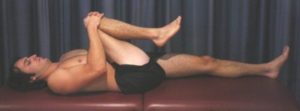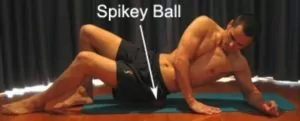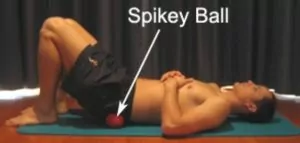Myofascial Pain
Updated:
What is myofascial pain?
Myofascial pain is a reasonably common cause of buttock pain and is characterized by pain arising from tight bands of muscle or ‘knots’ (trigger points) in the gluteal muscles.
The gluteal muscles are a strong group of muscles situated at the back of the pelvis forming the buttock (figure 1). The gluteals primarily comprise of 3 major muscles including:

- Gluteus maximus
- Gluteus medius
- Gluteus minimus
These muscles originate from the pelvis and insert into the top of the thigh bone (femur) (figure 1). Several other smaller muscles lie deep to the gluteals such as the piriformis muscle.
The gluteal muscles are primarily responsible for straightening the hip during activity, stabilizing the pelvis and assisting with other movements of the hip such as hip rotation and side elevation. They are particularly active during running, jumping, squatting and lunging.
Excessively tight bands of muscle known as myofascial trigger points (knots) may form within the gluteal muscles due to lower back injuries, pelvic instability or overuse of the gluteal muscles. This can cause muscle and soft tissue shortening, increased pressure on local tissue and nerves and subsequent pain. When this occurs, the condition is known as myofascial pain.
The gluteus medius and piriformis muscles are two of the most common sites for the development of trigger points and subsequent myofascial pain.
Causes of myofascial pain
Myofascial pain in the buttock region typically occurs due to excessive tightness of the gluteal and / or piriformis muscles. This may occur following a lower back injury, due to pelvic instability or following overuse of the gluteal muscles. Myofascial pain is more common in sports or activities requiring repeated use of the gluteal muscles. These activities may include: running (especially changing direction), sprinting, jumping, squatting or lunging.
Signs and symptoms of myofascial pain
Patients with this condition typically experience a pain or ache that is felt within the buttock. Occasionally, pain may radiate into the back of the thigh, calf, ankle or foot. Patients with myofascial pain in the buttock typically experience an increase in pain when placing the affected muscles on stretch (i.e. taking your knee towards your opposite shoulder) or during forceful gluteal or piriformis muscle contraction (e.g. when running and changing directions). Other activities that may aggravate symptoms include: sitting, climbing stairs, squatting and lunging. In addition, patients may also have reduced hip range of movement, a feeling of tightness in the buttock region and tenderness on firm palpation of the gluteal or piriformis muscles. Often palpation of these trigger points is tender and applying pressure to them may sometimes refer pain or symptoms down the leg.
Diagnosis of myofascial pain
A thorough subjective and objective examination from a physiotherapist is usually sufficient to diagnose myofascial pain. Occasionally, further investigations such as an X-ray, MRI, CT scan or Ultrasound may be required, to assist diagnosis and rule out other potential causes.
Treatment for myofascial pain
Most patients with this condition heal well with appropriate physiotherapy. It is important to note that since this condition is a secondary phenomenon, identification and treatment of the underlying cause of the myofascial pain is essential to ensure an optimal outcome.
The success rate of treatment for patients with this condition is largely dictated by patient compliance. One of the key components is that the patient rests sufficiently from any activity that increases their pain until they are symptom free. This allows the body to begin the healing process in the absence of further tissue damage. Once the patient can perform these activities pain-free a gradual return to these activities is indicated provided there is no increase in symptoms.
Ignoring symptoms or adopting a ‘no pain, no gain’ attitude is likely to lead to the problem becoming chronic. Immediate, appropriate treatment in all patients with this condition is essential to ensure a speedy recovery. Once the condition is chronic, healing slows significantly resulting in markedly increased recovery times.
Hands on treatment from a physiotherapist involving techniques such as soft tissue massage, joint mobilization, dry needling and electrotherapy can significantly hasten recovery and improve symptoms.
A graduated flexibility and strengthening program guided by a physiotherapist is essential to restore flexibility and recondition the affected muscles. This is essential to reduce the likelihood of injury recurrence in patients with myofascial pain.
In the final stages of rehabilitation, a gradual return to sport or activity is indicated as guided by a physiotherapist. This can commence once symptoms have resolved and adequate strength and flexibility of the affected muscles has been obtained.
Prognosis of myofascial pain
With early diagnosis of the underlying cause of the myofascial pain and appropriate management, most patients with this condition can usually recover in days to weeks. In severe or chronic cases of myofascial pain, recovery may take significantly longer.
Contributing factors to the development of myofascial pain
There are several factors which can predispose patients to developing this condition. These need to be assessed and corrected with direction from a physiotherapist. Some of these factors include:
- muscle tightness (particularly the piriformis, gluteal or adductor muscles)
- poor hip joint flexibility
- muscle weakness (particularly the piriformis and gluteals)
- lower back injury
- pelvic instability
- excessive or inappropriate training
- poor biomechanics
- inadequate warm up
- poor core stability
- muscle imbalances
Physiotherapy for myofascial pain
Physiotherapy for patients with this condition is vital to hasten the healing process, ensure an optimal outcome and reduce the likelihood of injury recurrence. Treatment may comprise:
- soft tissue massage
- trigger point release techniques
- electrotherapy (e.g. ultrasound)
- stretches
- dry needling
- muscle energy techniques
- joint mobilization
- neural mobilization
- ice or heat treatment
- education
- biomechanical correction
- progressive exercises to improve strength, flexibility and core stability
- activity modification advice
- technique correction
- devising and monitoring a return to sport or activity plan
Other intervention for myofascial pain
Despite appropriate physiotherapy management, some patients with this condition do not improve adequately. When this occurs, the treating physiotherapist or doctor can advise on the best course of management. This may include investigations such as an ultrasound, CT scan or MRI, pharmaceutical intervention, corticosteroid injection, or referral to appropriate medical authorities who can advise on any intervention that may be appropriate to improve the condition. In very rare cases of severe or recalcitrant myofascial pain, surgical intervention may be considered.
Exercises for myofascial pain
The following exercises are commonly prescribed to patients with this condition. You should discuss the suitability of these exercises with your physiotherapist prior to beginning them. Generally, they should be performed 3 times daily and only provided they do not cause or increase symptoms.
Gluteal Stretch Supine
Begin lying on your back (figure 2). Using your hands, take your knee towards your opposite shoulder until you feel a stretch in the buttocks or front of your hip. Hold for 15 seconds and repeat 4 times at a mild to moderate stretch pain-free.

Gluteal Stretch Prone
Begin this stretch on your hands and knees (figure 3). Place the leg to be stretched under your stomach / chest, with your knee in front of your hips and your foot to the side as demonstrated. Gently lower your upper body towards the ground, keeping your back leg straight, until you feel a stretch in the buttock. Hold for 15 seconds and repeat 4 times at a mild to moderate stretch pain-free.

Gluteal Self Massage
Place the spikey massage ball under your gluteals (buttock) as demonstrated (figure 4). Using your arms and legs, slowly move your body forwards and backwards, and from side to side, allowing the spikey ball to massage your buttock region. Breathe normally keeping your legs relaxed. Repeat this process for 15 – 90 seconds provided it is comfortable and does not cause pain. You can also apply sustained pressure to a particular tight spot for periods of 15 – 60 seconds or until the muscle relaxes.
This self massage exercise can also be performed lying on your back in the position demonstrated (figure 5).


Other Exercises
- View more Gluteal Stretches.
- View more Gluteal Strengthening Exercises.
Find a Physio
Find a Physiotherapist in your local area who can treat myofascial pain.
Physiotherapy products for myofascial pain
Some of the most commonly recommended physiotherapy products for patients with myofascial pain include:
To purchase physiotherapy products for myofascial pain click on one of the above links or visit the PhysioAdvisor Shop.

Link to this Page
If you would like to link to this article on your website, simply copy the code below and add it to your page:
<a href="https://physioadvisor.com.au/injuries/buttock/myofascial-pain”>Myofascial Pain – PhysioAdvisor.com</a><br/>PhysioAdvisor offers detailed physiotherapy information on myofascial pain in the gluteal region including: causes, symptoms, diagnosis, treatment, exercises, physiotherapy products and more...
Return to the top of Myofascial Pain.





